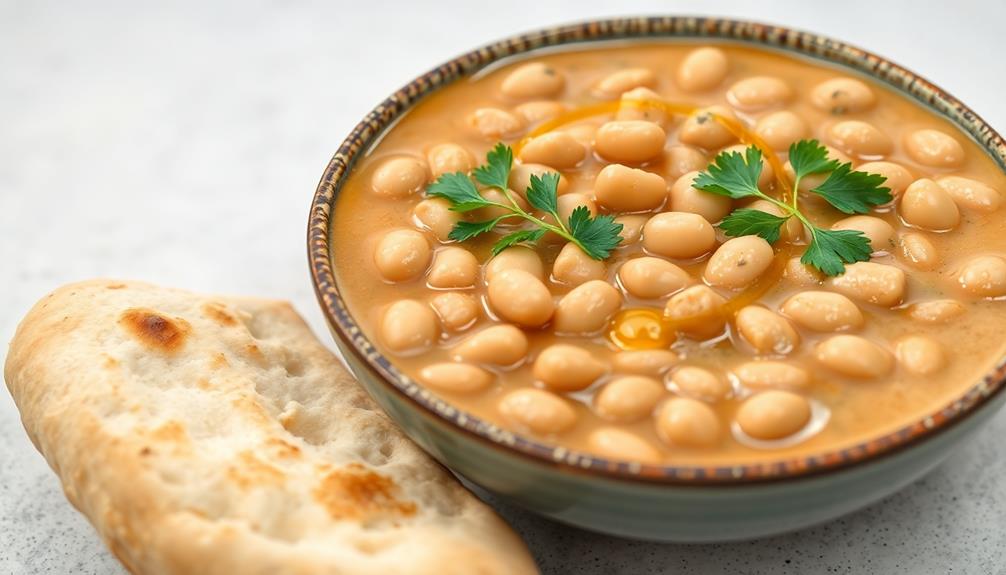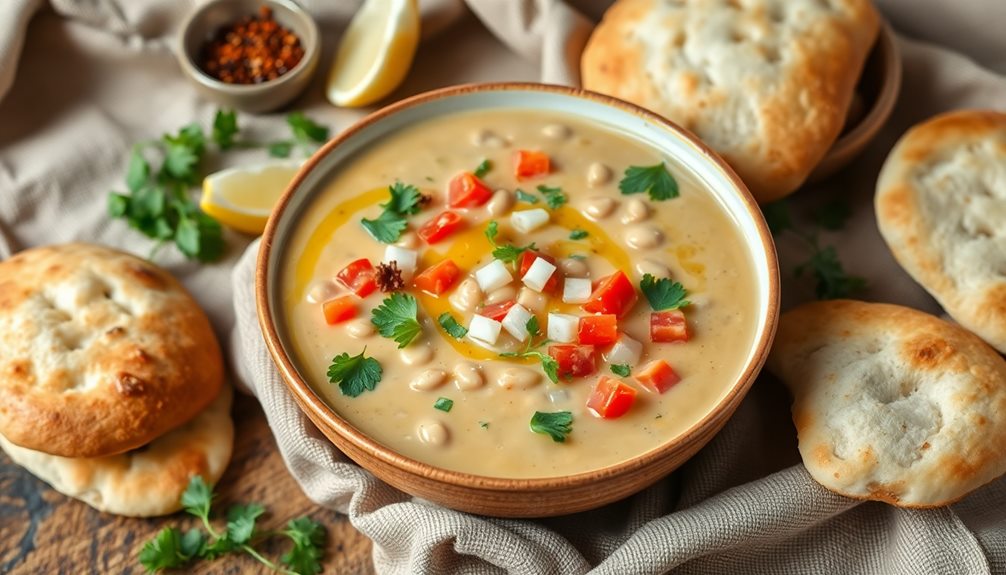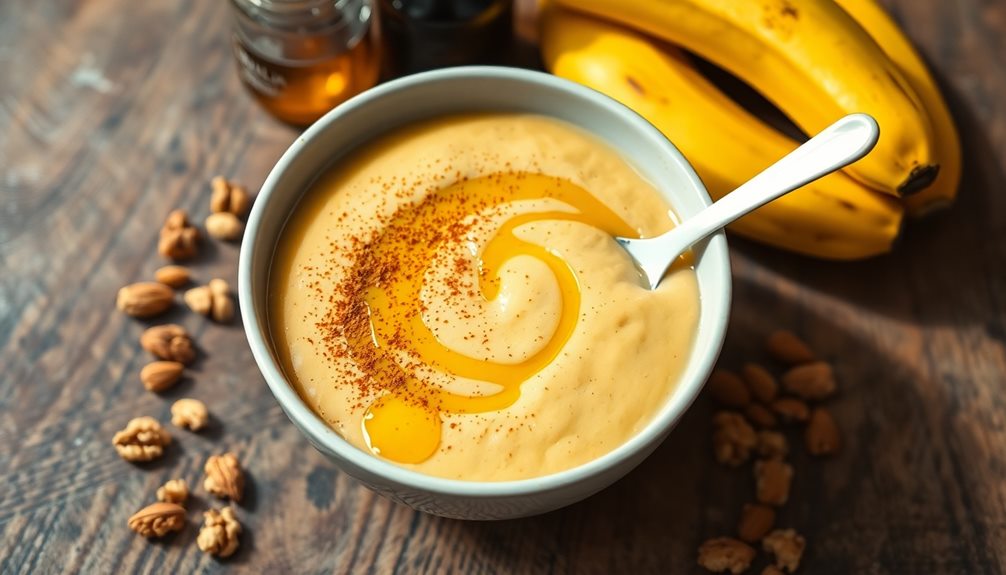Fool is a tasty Egyptian comfort food made with fava beans, and it's sure to warm your heart! It's been enjoyed for thousands of years, often shared during family meals and special celebrations. To make it, you soak fava beans overnight, blend them smooth, and mix in garlic, lemon juice, and spices. After chilling, you serve it with a drizzle of olive oil. This dish is not only delicious but also packed with nutrients, making it a great choice for anyone, including veggies! Want to explore more about this delightful dish and its rich history? There's so much more to uncover!
Key Takeaways
- Fool is a traditional Egyptian dish made primarily from fava beans, deeply rooted in the country's history and culture.
- Rich in nutrients, fava beans are a healthy comfort food option, offering high protein and dietary fiber with low fat content.
- The preparation of Fool involves soaking, blending fava beans, and adding spices, garlic, and lemon for enhanced flavor.
- Often served chilled, Fool is typically drizzled with olive oil and accompanied by pita bread or fresh vegetables.
- Fava beans are versatile and can be used in various recipes, showcasing their adaptability in both simple and complex dishes.
History
Fava beans have been a staple in Egyptian cuisine for thousands of years, dating back to ancient times when they were cultivated along the Nile. You might be surprised to learn that these beans were often eaten by workers who built the pyramids. Can you imagine that? They needed lots of energy, and fava beans provided just that!
As time went on, fava beans became an important part of Egyptian culture. People cooked them in various ways, often enjoying them in simple meals. Imagine sitting around a table with family, sharing stories while savoring delicious fava bean dishes!
In fact, fava beans are so loved that they're often used in celebrations and religious festivals. Throughout the years, these beans have remained a symbol of comfort and home. Many families have their own special recipes passed down through generations.
You might even find your own way to cook them someday! Fava beans are more than just food; they're a connection to history, culture, and family. So, the next time you enjoy a dish made with fava beans, remember you're tasting a piece of Egypt's rich past!
Cooking Steps
To whip up a delicious dish using fava beans, you'll first want to gather your ingredients and prep your workspace.
You'll need fava beans, garlic, lemon juice, olive oil, salt, and pepper. Don't forget some fresh herbs, like parsley, for an extra zing!
Next, soak the fava beans overnight in water. This helps them cook faster and makes them super soft.
When you're ready to cook, drain the beans and put them in a pot with fresh water. Bring it to a boil, then let it simmer for about an hour or until they're tender.
While the beans are cooking, chop your garlic and herbs.
Once the beans are soft, mash them with a fork or potato masher. Stir in the garlic, lemon juice, olive oil, salt, and pepper.
Mix everything until it's creamy and smooth.
Step 1. Soak Fava Beans Overnight
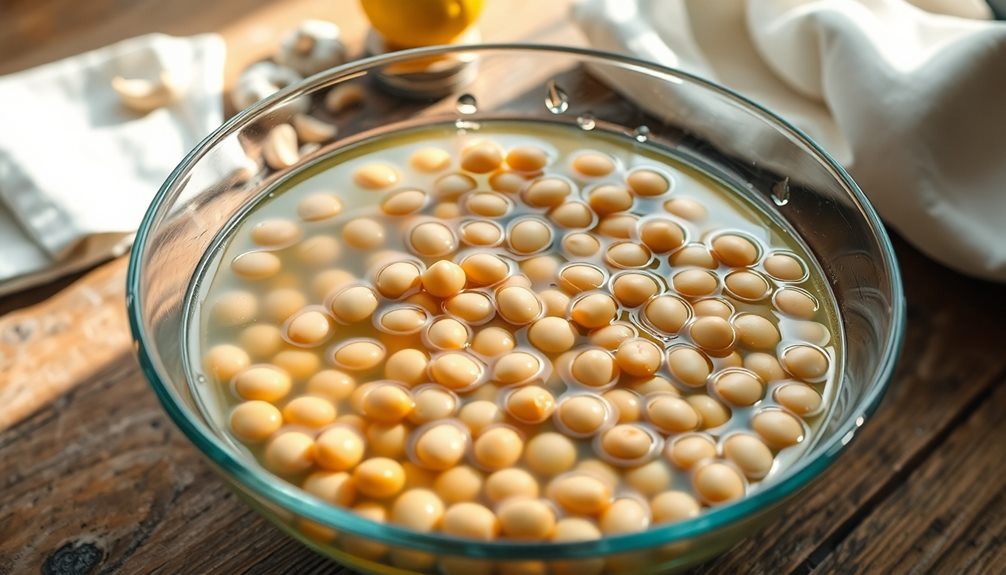
Soaking fava beans overnight is a crucial step in preparing this beloved Egyptian comfort food. When you soak the beans, they absorb water, which makes them softer and easier to cook. This also helps to reduce cooking time, so you won't be waiting forever to enjoy your delicious meal!
To start, grab a bowl and measure out the fava beans you need. Rinse them under cool water to remove any dust or dirt. Once they're clean, put them in the bowl and cover them with plenty of water. Make sure there's at least two inches of water above the beans, as they'll swell as they soak.
Now, set the bowl aside in a cool spot or even in the fridge. Leave the beans to soak overnight, or about 8 hours if you can't wait! You'll notice they'll become plump and tender.
This soaking process not only makes them easier to cook but also enhances their flavor. So go ahead and get those fava beans soaking! You're one step closer to making a yummy dish that'll warm your heart and fill your tummy.
Step 2. Blend Fava Beans Smoothly
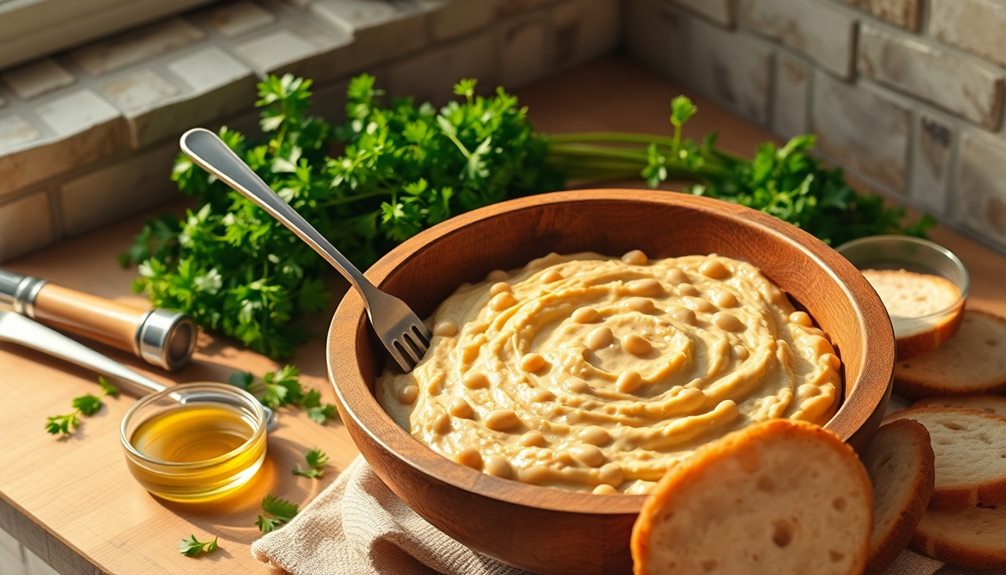
After letting your fava beans soak overnight, it's time to blend them into a smooth, creamy mixture.
First, drain the soaked beans and rinse them under cool water. This helps remove any leftover grit.
Next, place the beans in your blender or food processor. Add a splash of water to help get everything moving. You want just enough liquid to create a smooth texture, so start with a little and add more as needed.
Now, blend those beans! You might need to stop occasionally to scrape down the sides of the blender. This ensures all the beans get mixed in well.
Keep blending until you achieve that velvety consistency that makes your mouth water! If it feels too thick, don't hesitate to add a bit more water to loosen it up.
Once it's all blended, taste a tiny spoonful. You might want to adjust the texture a bit more.
When you're happy with the creaminess, transfer the mixture to a bowl. You've just made the perfect base for your delicious Egyptian dish! Get ready to add some exciting flavors next!
Step 3. Add Spices and Herbs
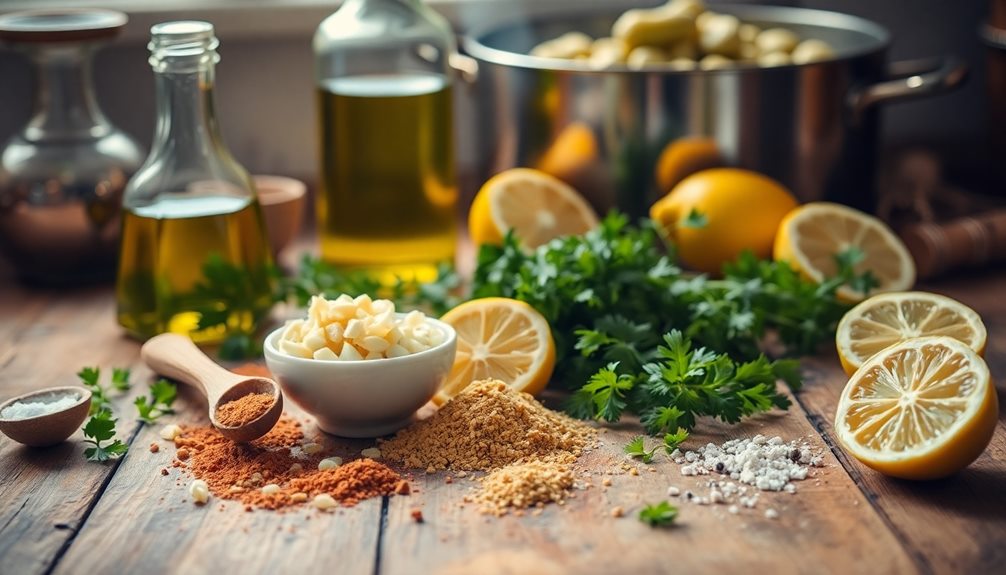
Infusing your fava bean mixture with spices and herbs transforms it from a simple base into a flavorful delight. To start, grab some cumin, a spice that adds a warm, earthy taste. Just a teaspoon can make a big difference!
Next, sprinkle in some paprika for a hint of smokiness and a beautiful color. You might also want to add a pinch of salt and pepper to bring out all those yummy flavors.
Now, let's talk about the herbs! Fresh parsley is a must; it adds a bright, fresh taste and makes your dish look pretty too. Chop a handful and mix it right in.
If you like a little zing, consider adding some fresh lemon juice. It's like sunshine for your fava beans!
Don't forget garlic! Minced garlic gives your dish a fantastic aroma and a zesty kick. Stir everything together until the spices and herbs are well blended.
Taste your mixture and adjust the spices if you'd like more flavor. With these simple additions, you'll create a warm, comforting dish that's bursting with taste, making everyone at the table smile! Enjoy your delicious creation!
Step 4. Chill Mixture Before Serving
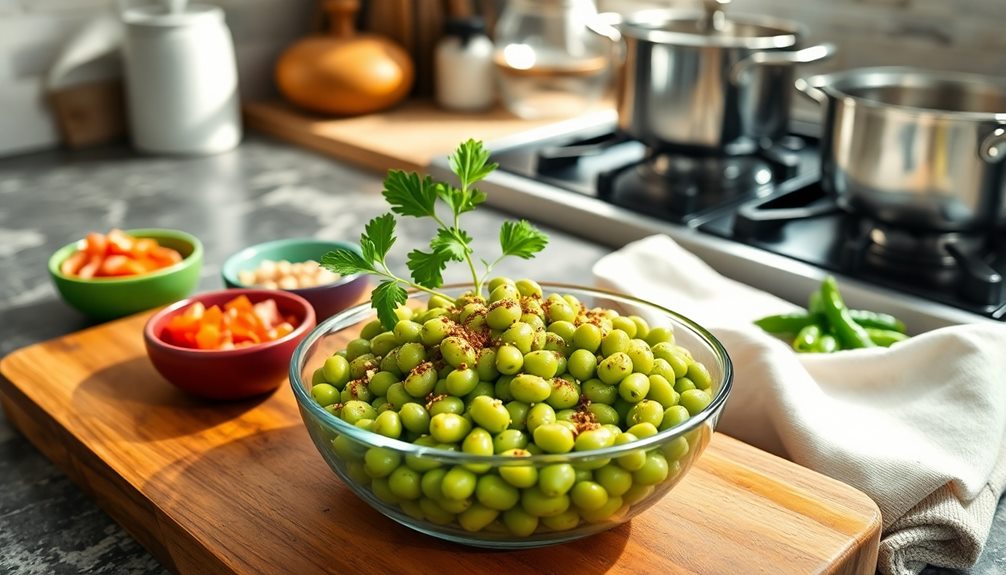
Chilling your fava bean mixture before serving enhances its flavors and makes for a refreshing dish. Once you've mixed in all the spices and herbs, it's time to let those delicious flavors meld together.
Grab a bowl and scoop your mixture into it. Cover it well with plastic wrap or a lid to keep it fresh. This step is similar to how regular maintenance prevents costly surprises in automotive care by allowing flavors to develop fully.
Now, find a spot in your fridge where it can chill for at least an hour, or even longer if you have the time! The cool temperature helps the flavors blend beautifully, creating a dish that's not only tasty but also refreshing.
While it's chilling, you can think about what you'd like to serve it with. You might even want to prepare some crunchy pita bread or fresh veggies to enjoy alongside your fava bean delight!
Once the hour is up, take your mixture out of the fridge. Give it a little stir to mix everything again, and get ready to impress your family or friends with something special.
They'll love the cool, flavorful goodness of your fava bean dish, especially on a warm day. Enjoy every bite!
Step 5. Serve With Olive Oil Drizzle
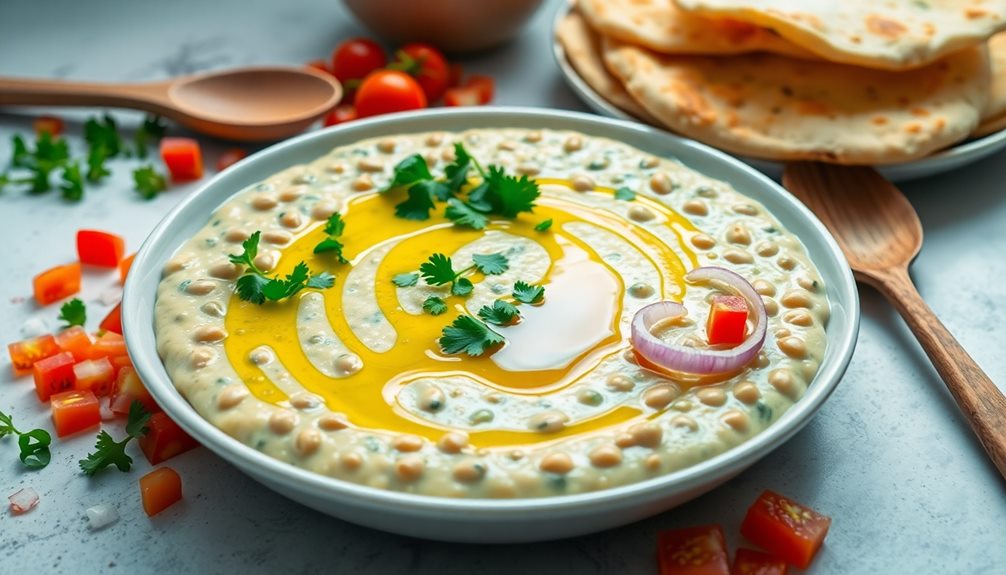
Once your fava bean mixture has chilled, it's time to take it to the next level with a drizzle of high-quality olive oil. This simple step adds a burst of flavor that will make your dish really shine! So grab that bottle of olive oil and let's get started.
First, take your chilled fava bean mixture and spoon it into a serving bowl. Make sure it looks nice and inviting!
Next, hold the olive oil bottle above the bowl. Gently squeeze or tilt it to let the oil flow in a thin stream over the beans. You don't need too much—just enough to give it that lovely, shiny finish.
As you drizzle, you might want to think about how olive oil isn't just tasty; it's also good for you! It's packed with healthy fats.
Once you've added the oil, it's time to serve your dish. You can even sprinkle a little salt or fresh herbs on top for extra flavor.
Now, gather your friends or family around and enjoy this delicious comfort food together! You've created something special, and everyone will love it!
Final Thoughts
When you savor the rich flavors of Egyptian comfort food, especially those featuring fava beans, you truly appreciate the heart of the cuisine. When prepared with care, dishes made from these humble yet hearty beans transform into soul-warming meals that highlight the simplicity and depth of Egyptian cooking. An Egyptian fava bean stew recipe, for instance, can showcase vibrant spices, luscious olive oil, and fresh herbs that elevate the dish into a comforting culinary masterpiece. Each bite tells a story of tradition, culture, and generations of home-cooked love.
This delicious dish, known as fool, warms your soul and fills your belly with joy. It's not just a meal; it's a connection to a culture that values togetherness and tradition.
As you explore the world of fava beans, you'll discover how versatile they are. You can enjoy them in many different ways, from simple preparations to more complex recipes.
Each bite is a reminder of the love and care that goes into cooking. Plus, serving fool with a drizzle of olive oil adds a touch of richness that makes it even more special.
Frequently Asked Questions
What Are the Health Benefits of Fava Beans?
Fava beans offer numerous health benefits. They're rich in protein, fiber, and essential nutrients, promoting heart health, aiding digestion, and providing energy. Including them in your diet can enhance overall well-being and support muscle growth.
Can I Use Canned Fava Beans for Fool?
Yes, you can use canned fava beans for your dish. They're convenient and save time. Just rinse them well before using to remove excess sodium, ensuring your meal stays healthy and delicious. Enjoy your cooking!
How Do I Store Leftover Fool?
To store leftover fool, let it cool to room temperature, then transfer it to an airtight container. Keep it in the fridge for up to three days, and reheat it before serving. Enjoy!
Is Fool Suitable for Vegans and Vegetarians?
Absolutely, fool is suitable for both vegans and vegetarians! It's made primarily from fava beans, which are plant-based. You'll find it's a nutritious and hearty option that fits perfectly within your dietary preferences. Enjoy!
What Dishes Pair Well With Fool?
When you enjoy fool, consider pairing it with fresh pita bread, tangy pickles, or a crisp salad. You might also love it alongside tahini sauce or a zesty tomato salad for added flavor.



